ABSTRACT
In this paper, C60 nanocrystals thin film with monocrystal thickness was prepared using a liquid-liquid interface. C60 nanocrystals dispersion prepared by reprecipitation method was added to n-hexane/water interface to form a thin film. The film was transferred onto an ITO substrate. Surface morphology of the film was studied by scanning electron microscope (SEM) and atomic force microscope (AFM) measurements. It was found that the density of the film increase with increasing the deposition number of layers with maintaining the monocrystal thickness.
Introduction
Organic nanocrystals have been studied extensively because of their unique physicochemical and optoelectronic properties for optical and electronic devices [Citation1]. Assembly of the nanocrystals in thin film is necessary for their application to functional devices, such as solar cells, transistor, etc.
Several techniques such as micro-contact printing [Citation2], the Langmuir-Blodgett [Citation3,Citation4], layer-by-layer (LbL) technique [Citation5] and electrophoretic deposition [Citation6] have been used to assemble nanomaterials in two and three dimensions as the bottom-up approaches.
Recently, liquid-liquid interface have applied to assemble inorganic nanoparticle [Citation7,Citation8]. Furthermore, not only a spherical nanoparticle but also a tubular nanomaterials such as carbon nanotubes can be assembled using the liquid-liquid interface [Citation9].
We have applied a liquid-liquid interface assembling technique to fabricate uniform thin films composed of organic nanocrystals [Citation10–12]. Ultrathin film of nanocrystals with different size and shape has been prepared using the assembling technique. In the previous study, we prepared C60 nanocrystals thin film using the liquid-liquid interfacial assembling technique [Citation10]. To the C60 nanocrystals dispersion, n-hexane was added to form an interface. Addition of ethanol to the interface, the C60 nanocrystals were assembled at the n-hexane/water interface [Citation10]. However density of the prepared film is low and their surface is relatively rough. High density film with uniform surface is required for efficient electron transport. In this study, the n-hexane/water interface was firstly prepared and the C60 nanocrystals/2-propanol dispersion was added to the interface. We found that C60 nanocrystals were assembled at the interface to form a thin film. The thin film was transferred onto an ITO substrate and the surface morphology was observed by SEM and AFM measurement. We found that the density and roughness of the film can be controlled by changing the deposition times and applying thermal treatment.
Experimental section
Fullerene C60 powder (> 99.5%) was purchased from Tokyo Kasei and indium tin oxide (ITO) substrate (20 mm × 25 mm) with a sheet resistance of 15 Ω/square was purchased from TECHNO PRINT. ITO substrates were cleaned by sonicating in acetone, distilled (DI) water, and 2-propanol for 10 min respectively, followed by boiling in 2-propanol for 5 min and treating by oxygen plasma for 20 min.
We fabricated C60 nanocrystals (NCs) by reprecipitation method [Citation13,Citation14]. C60/m-xylene solution (200 µL, 7 mM) was quickly injected into 10 mL of vigorously stirred 2-propanol solvent. The size of the NCs was determined to be 120 nm by the scanning electron microscope (SEM). The thin films of the C60 NCs were fabricated by the liquid-liquid interface assembly technique with two processes (). A vessel with a diameter of φ 44 mm was cleaned with 2-propanol. DI water (40 mL) followed by n-hexane (8 mL) were poured to the vessel to create a liquid-liquid interface. C60 NCs dispersion was added to the interface at the speed of 0.3 mL/h. We observed C60 NCs were assembled at the interface. An ITO substrate was dipped into the interface at 7.5 mm/min to transfer the film. The film was baked at 120 °C at 20 min after the deposition.
Deposited films were characterized by SEM (JSM-6700F; JEOL), atomic force microscope (AFM, Dimension ICON; BRUKER), and X-ray diffraction (XRD, SmartLab; Rigaku).
Results and discussion
C60 NCs formed a round shape particle with a mean diameter of 120 nm. The crystalline of C60 NCs were confirmed by XRD measurement.
The C60 NCs were assembled at the n-hexane/water interface by adding C60 NCs dispersion at the speed of 0.3 mL/h. 3 mL of the dispersion was added to the interface and the assembly was transferred onto an ITO substrate. The NCs were spread at the interface without forming a large aggregation. The amount of the dispersion to be added determined so that NCs fully covered the interface with monoparticle thickness. It should be mentioned that the hydrophilicity of the ITO substrate is important for efficient film transfer. The film deposition was not observed with the ITO substrate of water contact angle higher than 5°. The morphology of the deposited film was observed by SEM measurement (). It is clearly showed that the density of the film increased with increasing deposition number of process. The film density was roughly analyzed by the SEM images.
Figure 2. SEM images of thin films fabricated by the liquid-liquid interface assembly technique using the C60 NCs dispersion. The deposition times were (a) 1 time, (b) 2 times, (c) 3 times and (d) 4 times and baked at 120 °C for 20 min.

The density of the film reached to 86% at four successive deposition cycles (). The results indicate C60 NCs after the second cycle deposited onto the undeposited area of ITO and not onto the deposited C60 NCs films.
Figure 3. Coverage rate of thin films fabricated by the liquid-liquid interface assembly technique using the C60 NCs dispersion.

The surface roughness of the film was discussed by AFM measurement to confirm the deposition process. shows the AFM images with each deposition cycle. The AFM images of NCs film prepared by 1 cycle showed a rough surface with RMS of 116 nm. The roughness decrease with increasing deposition time and the film prepared by 4 cycles show a relatively smooth surface with RMS of 56.6 nm (). Moreover, C60 has a little solubility to n-hexane (0.04 g/mL) and the deposited film was etched with repeating the deposition, which smooth the surface of the film. As the results, the film prepared by multiple cycles formed a dense film with uniform surface.
Figure 4. The AFM images of fabricated thin films fabricated by liquid-liquid interface assembly technique using the C60 NCs dispersion. The deposition times were (a) 1 time, (b) 2 times, (c) 3 times and (d) 4 times and baked at 120 °C for 20 min.

Figure 5. Average value of RMS fabricated thin films by liquid-liquid interface assembly technique using the C60 NCs dispersion.

We also note that the deposited C60 NCs showed almost identical XRD spectra non- and with baking process (), indicating that the crystallinity of C60 was preserved.
Figure 6. XRD spectra of thin film of ITO, pristine nanocrystals layer, nanocrystals layer non-baking and nanocrystals layer with baking.

Baking process is other important factor to prepare a uniform thin film. When we carried out the deposition cycle without the baking process, the film density with 4 deposition cycle was calculated to be 81% (). The density of the film was not increase with increasing the deposition cycle more than 4 times. Comparing with non-baking (baking treatment after the end of deposition times) and with baking process (baking treatment after every deposition times), shows baking process is important process to obtain high coverage thin film. Baking process can remove water on the ITO substrate. In other words, it seems that adsorbed water tightly bound to the ITO surface disturbed the adsorption of C60 NCs.
Conclusion
We have successfully assembled C60 NCs with control density using the liquid-liquid interface assembling technique. The density of the C60 NCs thin films increased with increasing deposition process, whereas the surface roughness decrease with deposition cycles. The uniform film with high density will be useful for electron accepting layer in in organic solar cell. Moreover, this simple technique can also use for different particle sizes (e.g. 70 nm).
Acknowledgment
Masuhara A. thanks to Asahi Glass Foundation and Tokyo Ohka Foundation provided financial supports. Matsui J. thanks to Grand-in-Aid for Scientific Research on Innovative Areas “New Polymeric Materials Based on Element-Blocks (No. 2401)” 25102505 for the financial supports. This study was supported by Research Center for Organic Electronics (ROEL) for the use of SEM and XRD.
References
- Masuhara, A., Tan, Z., Ikeshima, M., Sato, T., Kasai, H., Oikwa, H., & Nakanishi, H. (2012). Cryst. Eng. Comm., 14, 7787.
- Kinge, S., Crego-Calama, M., & Reinhoudt, D.N. (2008). Chem. Phys. Chem, 9, 20.
- Acharya, S., Hill, J.P., & Ariga, K. (2009). Adv. Mater., 21, 2959.
- Decher, G. (1997). Science, 277, 1232.
- Srivastava, S. & Kotov, N.A. (2008). Acc. Chem. Res., 41 (12), 1831.
- Masuhara, A., & Sato, T. (2013). Mol. Cryst. Liq. Cryst., 580, 47.
- Duan, H.W., Wang, D.A., Kurth, D.G., & Mohwald, H. (2004). Angew. Chem. Int. Edit., 43, 5639.
- Reincke, F., Hichey, S.G., Kegel, W.K., & Vanmaekelbergh, D. (2004). Angew. Chem. Int. Edit., 43, 458.
- Matsui, J., Iko, M., Inokuma, N., Orikasa, H., Mitsuishi, M., Kyotani, T., & Miyashita, T. (2006). Chem. Lett., 35, 42.
- Kudo, R., Matsui, J., Yokoyama, T., Masuhara, A., Kasai, H., Oikawa, H., & Miyashita, T. (2011). Mol. Cryst. Liq. Cryst., 539, 68.
- Matsui, J., Shibata, T., Yokoyama, T., Masuhara, A., Kasai, H., Oikawa, H., & Miyashita, T. (2012). Nanoscale., 4, 3857.
- Matsui, J., Shibata, T., Yamamoto, K., Yokoyama, T., Masuhara, A., Kasai, H., Oikawa, H., & Miyasita, T. (2009). Synthetic Metals, 159, 847.
- Tan, Z., Masuhara, A., Kasai, H., Nakanishi, H., & Oikawa, H. (2008). Jpn. J. Appl, Phys., 47, 1426.
- Masuhara, A., Tan, Z., Kasai, H., Nakanishi, H., & Oikawa, H. (2009). Jpn. J. Appl, Phys., 48, 50206.


